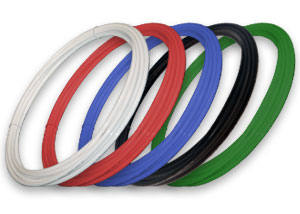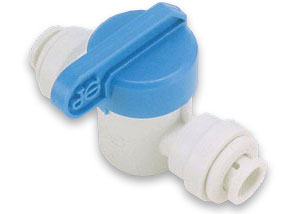The following inorganic contaminants, if present in your drinking water in normally found concentrations, will be removed or reduced to safe levels by filtration with reverse osmosis membranes, such as found in our reverse osmosis systems.
INORGANIC COMPOUNDS |
|||||
|---|---|---|---|---|---|
| Contaminant | MCL (mg/L) | Source/Industrial Occurrence | Health Effects | Treatment | |
| Antimony | 0.005 | Coal and ore mining, petroleum refining, paint and ink formulation, textile mills, explosives mfg., foundries timber product processing, iron and steel mfg. as a hardening alloy. | Carcinogen. Irritation to eyes and skin tissue. | Reverse osmosis, coagulation and filtration, distillation. | |
| Arsenic | *0.05 *USEPA to consider MCL between 0.002 to 0.02 mg/L |
Defoliants, soil sterilants, wood treatment compounds, used in textile mills, paint and ink formulation, petroleum refining, porcelain enameling, pharmaceutical manufacturing, ore mining and dressing, foundries and metals manufacturing. | Malignant tumors or skin and lungs. Affects nervous system. | Reverse osmosis, activated alumina, ion exchange, lime softening, coagulation with filtration distillation. | |
| Asbestos | 7 MF/L | Natural mineral deposits, insulation, fireproofing materials and cement pipe. | Probable cause of cancer. | Reverse osmosis, filtration, distillation. | |
| Barium | 2.0 | Natural forming ore as barite and witherite in GA, MO, AR, KY, CA, NV, Canada and Mexico. | Affects nervous and circulatory systems. | Reverse osmosis, ion exchange, lime softening, distillation. | |
| Berrylium | 0.004 | Natural ore in CO, ME, NH, SD, Canada. Nonferrous metals manufacturing as a copper alloy, iron and steel manufacturing, ore and coal mining, textile mills petroleum refining, paint and ink formulation. | Carcinogen. Effects skin and lung tissues. | Reverse osmosis, ion exchange, activated alumina, coagulation and filtration, lime softening, distillation. | |
| Cadmium | 0.005 | Natural mineral deposits. Used in leather and tanning and iron and steel manufacturing, coal mining, textile mills, gum and wood chemicals, pharamacuetical manufacturing, petroleum refining, rubber processing and foundries. | Kidney disorders, bronchitus, anemia. | Reverse osmosis, Ion exchange, coagulation with filtration, lime softening, distillation, corrosion control. | |
| Chromium (total) |
0.1 | Natural mineral deposits. Used in leather and tanning and iron and steel manufacturing, coal mining, textile mills, gum and wood chemicals, pharmaceutical manufacturing, petroleum refining, rubber processing and foundries | Liver and kidney disorders. Affects skin and digestive system. | Reverse osmosis, Coagulation with filtration, ion exchange, lime softening, distillation. | |
| Copper | 1.3 (action level) | Formation occurs during corrosion of interior household and building pipes. | Stomach and intestinal distress. Wilson’s Disease. | Reverse osmosis, ion exchange, distillation. | |
| Cyanide | 0.2 | Leather tanning and finishing, iron and steel manufacturing, paint and ink formulation, extermination materials, explosives manufacturing. | Nervous system, endocrine system. | Reverse osmosis, chlorination, ion exchange. | |
| Fluoride | 4.0 | Natural forming material deposits, additive to public supply as fluorsilicic acid, sodium silicofluoride or sodium fluoride at a concentration of 1.0 mg/L. | Fluorosis or mottling, a brown discoloration of the teeth. | Reverse osmosis, ion exchange, distillation, activated alumina. | |
| Lead | 0.015 (action level) | Solder and other plumbing products, batteries, gasoline as tetraethyl lead. Used in explosives manufacturing, textile mills, petroleum refining, paint and ink formation, rubber processing, porcelain enameling and foundries. | Affects nervous and reproductive systems and kidneys. Causes hypertension. | Reverse osmosis, ion exchange, coagulation with filtration, distillation, corrosion control, carbon. | |
| Mercury | 0.002 | Fungicides, bactericides in antifouling paints and mildew-proofing preparations. Also found in thermometers and barometers. Used in coal mining, textile mills, timber product processing, petroleum refining, rubber processing, paint and ink formulation. | Affects nervous system and kidneys. | Reverse osmosis, granular activated carbon, lime softening, coagulation with filtration and with powdered activated carbon, distillation. | |
| Nickel | 0.1 | Natural ore in Ontario, Canada, iron and steel manufacturing as low alloy steel, nonferrous manufacturing as copper and brass. Alkaline storage batteries, electroplating, foundries, timber product processing, petroleum refining. | Carcinogen, dermatitis. Affects gastrointestinal and central nervous systems. | Reverse osmosis, lime softening, ion exchange, distillation. | |
| Nitrate (as N) | 10 | Fertilization, sewage. Natural forming mineral deposits, feed-lot runoff. | Methemo-globinemia (“Blue Baby” Syndrome) | Reverse osmosis, ion exchange, distillation | |
| Nitrite (as N) | 1.0 | Fertilization, sewage. Natural forming mineral deposits, feed-lot runoff. | Methemo-globinemia (“Blue Baby” Syndrome) | Reverse osmosis, ion exchange, distillation | |
| Selenium | 0.05 | Natural mineral deposits. Commonly found as a trace element in animal feeds. Used in textile mills, timber processing, porcelain enameling, pharmaceutical manufacturing and foundries. | Affects nervous system. Causes irriation to the mucous | Reverse osmosis, distillation, lime softening, coagulation with filtration, activated alumina. | |
| Sodium | none (20 mg/L recommended level) |
Geological, road salting. | Possible increased blood pressure in suseptible individuals. | Reverse osmosis, ion exchange, distillation. | |
| Thallium | 0.002 | Pesticides, nonferrous metals as an alloy, photo electric applications, semi conductor processing, petroleum refining, paint and ink formulation. | Skin irritation. | Reverse osmosis, activated alumina, ion exchange, distillation. | |
The following organic contaminants, if present in your drinking water in normally found concentrations, will be removed or reduced to safe levels by filtration with granular activated carbon, such as found in our reverse osmosis systems.
ORGANIC COMPOUNDS |
|||||
|---|---|---|---|---|---|
| Contaminant | MCL (mg/L) | Source/Industrial Occurrence | Health Effects | Treatment | |
| Acrylamide | TT | Flocculents in sewage and wastewater treatment. | Affects nervous system. Probable cause of cancer. | Granular activated carbon. | |
| Benzene | 0.005 | Used in fuels (leaking underground storage tanks). Used as a solvent in manufacturing pharmaceuticals, plastics, pesticides and paints. | Leukemia, anemia and possibly cancer. | Granular activated carbon. | |
| Carbon tetrachloride | 0.005 | Used as a cleaning agent and in manufacturing of refrigerants, fumigants, propellants, resins, paint and ink formulation. | Affects nervous system, liver and digestive system. Causes cancer. | Granular activated carbon. | |
| Dibromochl-oropropane (DBCP) | 0.0002 | Soil fumigant on soybeans, cotton; discontinued in 1977. | Probable cause of cancer. | Granular activated carbon. | |
| Dichloro-methane | 0.005 | Paint removers, solvent degreasing, aerosol sprays, fumigants, plastics manufacturing, photographic film, textile and leather coatings, foam products. | Carcinogen | Granular activated carbon. | |
| Di(ethylhexyl) adipate | 0.4 | Plasticizer and polymer production, lubricants. | Probable cause of cancer. | Granular activated carbon. | |
| Di(ethylhexyl) phthalate | 0.006 | Plasticizer in resins and elastomers | Probable cause of cancer. | Granular activated carbon. | |
| p-Dichloro-benzene | 0.075 | Used in moth repellent, germicides, pesticides and soil fumigants. | Affects nervous system, kidneys and liver. Probable cause of cancer. | Granular activated carbon. | |
| o-Dichloro-benzene | 0.6 | Used in manufacturing of fumigants, insecticides, waxes, resins, rubber and asphalt. | Affects lungs, liver and kidneys. | Granular activated carbon. | |
| 1,2-Dichloroethane | 0.005 | Used in manufacturing of gasoline, paint, varnish, metal degreasing and insecticide fumigants. | Causes damage to kidneys and liver, can cause nausea. | Granular activated carbon. | |
| 1,1-Dichloroethylene | 0.007 | Used in manufacturing of dyes, plastics, perfumes and adhesives. | Affects kidneys and liver, can cause nausea. | Granular activated carbon. | |
| cis-1,2-Dichloroethylene | 0.07 | Used as an industrial solvent in manufacturing of dyes, perfumes and lacquers. | Affects liver, and nervous and circulatory systems. | Granular activated carbon. | |
| trans-1,2-Dichloroethylene | 0.1 | Used as an industrial solvent in manufacturing of dyes, perfumes, lacquers and rubber. | Affects liver, and nervous and circulatory systems. | Granular activated carbon. | |
| 1,2-Dichloropropane | 0.005 | Used in insecticidal fumigants, dry cleaning fluids and in manufacturing of resins, waxes and petroleum products. | Affects lungs, liver and kidneys. | Granular activated carbon. | |
| Epichlorohydrin | TT | Epoxy resins and coatings. Flocculents used in treatment. | Affects kidneys, liver and lungs. Probable cause of cancer. | Granular activated carbon. | |
| Ethylbenzene | 0.7 | Used in manufacturing of gasoline, insecticides and asphalt. | Affects nervous system, liver and kidneys. | Granular activated carbon. | |
| Ethylene dibromide (EDB) | 0.00005 | Used as gasoline additive and soil fumigant. | Probable cause of cancer. | Granular activated carbon. | |
| Hexachloro-benzene | 0.001 | Fungicide/wood preservative | Digestive system, cancer. | Granular activated carbon. | |
| Hexachloro-cyclopentadiene | 0.05 | Pesticides, fungicides, dyes and resins. | Skin irritant, lungs and digestive system. | Granular activated carbon. | |
| Monochloro-benzene | 0.001 | Fungicide/wood preservative | Digestive system, cancer. | Granular activated carbon. | |
| PAHs – Polynuclear Aromatic Hydrocarbons Benzo(a) Pyrene | 0.0002 | Coal and core processing, heat/power processing, shale refining | Cancer | Granular activated carbon. | |
| Styrene | 0.1 | Used in manufacturing of plastics, resins and foams. | Affects nervous system, liver and kidneys. | Granular activated carbon. | |
| 2,3,7,8-TC-DD (Dioxin) | 3×10-8 | Defoliants/herbicides | Carcinogen, mutagen, tetragen | Granular activated carbon. | |
| Tetrachloro-ethylene (PCE) | 0.005 | Used in dry cleaning, degreasing agent for metals, for manufacturing rubber, waxes, paints and inks. | Affects nervous system. Probable cause of cancer. | Granular activated carbon. | |
| Toulene | 1.0 | Used in gasoline, paints, thinners, lacquers and adhesives | Affects nervous system, liver and kidneys. Causes narcosis. Irritant to respiratory system. | Granular activated carbon. | |
| 1,2,4-Trichlorobenzene | 0.009 | Insecticides, lubricants, dye processing, transformer fluid | Digestive system and lungs | Granular activated carbon. | |
| 1,1,1-Trichloroethane | 0.2 | Used in manufacturing of pesticides, plastics and metals. | Affects nervous system. Causes narcosis and probably cancer. | Granular activated carbon. | |
| 1,1,2-Trichloroethane | 0.005 | Solvent used in oils, fats, waxes and resins, rubber processing. | Immune system. | Granular activated carbon. | |
| Trichloroethylene | 0.005 | Used in dry cleaning and as a degreasing agent. Used in manufacturing of rubber, paints, adhesives and resins, oils, and fumigants. | Irritant of body tissue. Affects nervous system. Probable cause of cancer. | Granular activated carbon. | |
| Total trihalomethanes (THMs) – Chloroform, Bromoform, Bromodichloro-methane, Dibromochloro-methane | 0.1 | Formation occurs when water containing organic matter is treated with chlorine. | Affects nervous system and muscles. Probable cause of cancer. | Granular activated carbon. | |
| Vinyl chloride | 0.002 | Used as a plastic adhesive and refrigerant, the main component of PVC pipe. | Affects nervous system. Probable cause of cancer. | Granular activated carbon. | |
| Xylenes (total) | 10 | Used in manufacturing of paint, ink, petroleum and detergents. | Affects nervous system, kidneys, lungs, liver and mucous membranes. | Granular activated carbon. | |















































